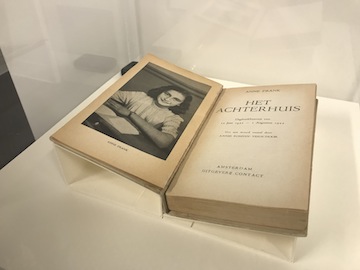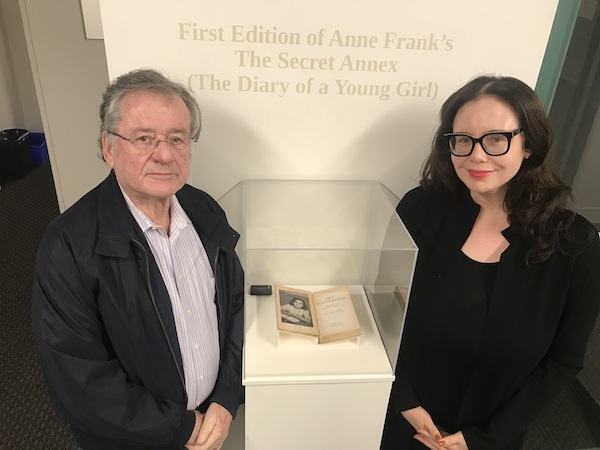Dr. Robert Krell and VHEC executive director Nina Krieger at the display case for Het Achterhuis, a first edition of Anne Frank’s Diary of a Young Girl. (photo by Shula Klinger)
In November 2017, the Jewish Independent published the story of a first edition of Anne Frank’s Diary of a Young Girl, that had come to light in North Vancouver (jewishindependent.ca/retribution-and-restoration).
The edition had been purchased by bookbinder Richard Smart from an estate sale in Holland. The book was badly damaged. The front cover had come apart and the spine had broken away from the bound pages. Inside the binding, pieces of another book had been used to pad the spine. It was common practice at a time when paper was scarce, but, in this case, the paper fragments came with a message. Taken from a German volume, the original bookbinder had positioned the title of the book, Die Vergeltung, where it could easily be seen. Its meaning: retribution.
Smart planned to sell the book but not to a private collector. He wanted it to remain in the public eye and be kept within the Jewish community.
A few weeks after the article was published, I received an email from Dr. Robert Krell in Vancouver. A survivor himself, he is a founder of the Vancouver Holocaust Education Centre. He wanted to know if the book was still for sale and could be purchased for the VHEC.
I passed Krell’s message to Smart at the Old English Bindery, and a conversation began about its possible sale. Two weeks later, I drove Smart and Emilie Crewe, the bindery’s administrator, to a meeting at Krell’s home. Krell and his assistant, Joy Fai, welcomed us, and we talked over coffee.
Krell explained his position on the sale, talking about the book’s precious legacy and his own feeling for history. It was deeply moving when he held the book for the first time and opened the cover to see the printed words in the spine.
For any lover of history, a volume like this can take a pretty firm hold on one’s imagination. When the volume is a treasure of this kind, in the hands of a Dutch Holocaust survivor, and – just possibly – with its own, private message of solidarity for those who perished, the power of this moment is immeasurable.
It took a few minutes to finalize the administrative aspects of the sale. Krell gave me a moment alone with the book, then I put it back in the decorative box Smart had crafted, wished Anne goodnight and closed the lid.
Het Achterhuis is now on display at the Vancouver Holocaust Education Centre. The case is situated next to the classroom where all school students begin their tours. It is, said Krell, “a high-traffic area,” so the children cannot fail to pass the book. And, while the centre’s artifact-driven exhibits include many extraordinary items, he said, “the symbolism of Anne reaches far more children than we can.”

Having said that, Krell added, “It’s symbolic for all the wrong reasons. It’s a lovely story of a bright girl who saw so much more than anyone else could, from that tiny room. The Dutch use this photo of a smiling adolescent girl as an example of Dutch resistance, but they have not yet apologized for what they did, the 100,000 Dutch Nazis.”
Krell spoke of the many ties between Holland and Canada, describing liberation day on May 5, 1945, by Canadian troops. Even now, Holland celebrates this day with a gift of tulip bulbs to Ottawa.
Asked why the first edition should be housed here, at the VHEC, Krell said, “Why not? We have been teaching students since 1976. We have earned the right to have a precious book to show our students and loyal teachers.”
Krell emphasized the educational role of the book – artifacts make history real for children, he said. And, “to continue our teaching, we have to use artifacts that survivors have left us. They are evidence of what happened and we have to show what they represent. A skipping rope, a toy, a tin cup, a utensil – that is the difference between life and death.”
Even more importantly, he said, “we’re in a phase of succession to the next generation, to carry the legacy of survivors. These include memories and warnings because we’re facing incredible racism and antisemitism in the world today.”
Contemplating the importance of remembering and teaching about the Holocaust, Krell offered a sombre analogy. At Auschwitz, he said, when prisoners were robbed of their last possessions, they were stockpiled in a spot they named “Canada,” the land of plenty. “Canada was in Auschwitz,” said Krell. “We must be careful not to bring Auschwitz back to Canada.”
Shula Klinger is an author and journalist living in North Vancouver. Find out more at shulaklinger.com.

